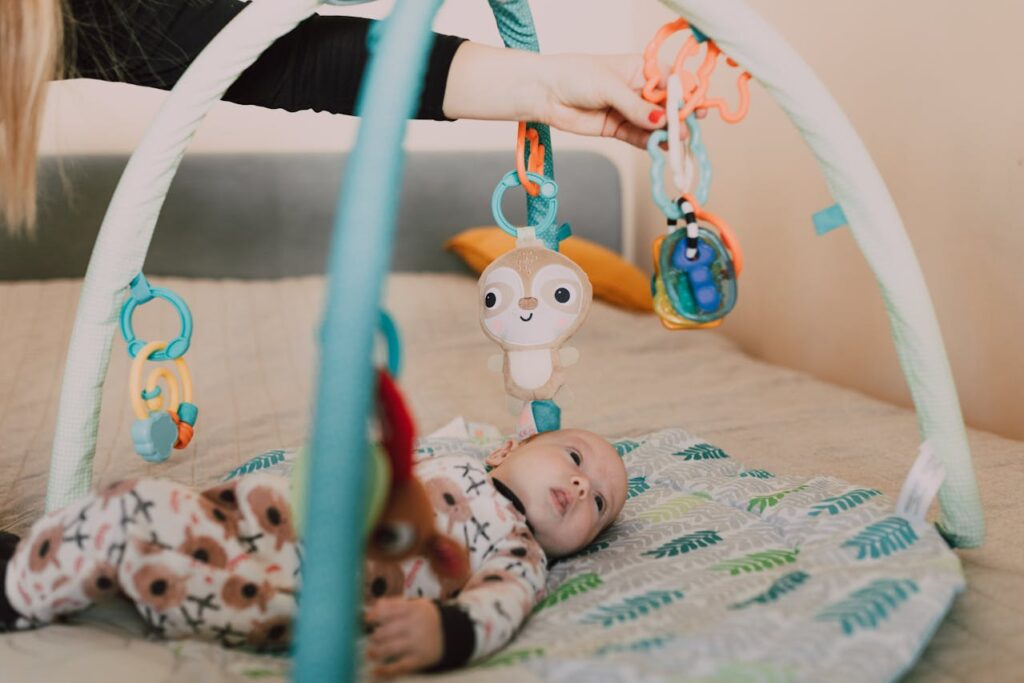Having a baby can be overwhelming. Parents often struggle to get their newborns to sleep in a bassinet. Don’t worry – our guide is full of practical tips and strategies. You can have your baby sleeping by the end of this article! How to get newborn to sleep in bassinet? Leave that to us.
Table of Contents
6 Tips: How to Get Newborn to Sleep in Bassinet

Newborn won’t sleep in bassinet? Have a look at our tips down below:
1. Bedtime Routine
Establish a regular bedtime routine if you want your newborn to get used to sleeping inside a bassinet. Babies love routines.
Routines don’t have to be complex. They can include a warm bath, massaging lotion onto their delicate skin, changing into pajamas, and telling stories or singing lullabies. These repetitive actions become familiar, and they get used to them pretty quickly.
2. Comfort

To ensure the baby’s comfort while sleeping in a bassinet, choose a firm-fitting, snug mattress with no gaps. Only use fitted sheets designed for bassinets. Nursery temperatures are usually between 68-72°F (20-22°C). This prevents newborns from overheating and freezing.
3. Swaddling
You can wrap your baby in a swaddle before putting them in the bassinet. This should help them to sleep. Swaddling is believed to resemble the womb’s environment, and it prevents the startle reflex that often wakes babies up.
To swaddle your infant, lay a soft, thin blanket on a flat surface, then put your baby in the middle with its head above the fold line. Take one side of the fabric and wrap it over your infant’s body before tucking it under them. Then, fold down the bottom edge towards your feet. Finally, pull another side of this cloth piece across your infant’s chest before tucking it under them. And there you go!
3. White Noise
White noise is an effective strategy for getting a newborn to sleep in a bassinet. It imitates sounds in the womb, creating familiarity that calms babies down quickly. It also blocks out other household noises that could interrupt their slumber.
You can use white-noise machines or fans. Place them at safe distances, as you don’t want the baby to be disrupted. Mobile phone apps are also an option! They are specifically designed to generate white noise.
4. Quiet and Dark Room
Curtains or blinds covering the windows can aid babies’ sleep in a bassinet. When it is dark, the body produces melatonin, a hormone that induces sleep. Blackout curtains prevent sunbeams from passing through windows. However, you can use a dim night light to see your baby without interfering with their slumber.
5. Feeding Before Bedtime

Feeding your newborn before putting them down in their bassinet may help. Feeding prevented hunger pains. A well-fed baby sleeps longer! You can make it part of your routine by giving them a feed just before bedtime, whether breastfeeding or bottle-feeding.
Ensure they have fed properly before laying them down for sleep. Some parents may offer what is known as “dream feed,” when parents breastfeed or bottle-feed their baby for one last time before going to bed themselves to prolong the baby’s sleep duration throughout the night.
6. Rocking or Swaying
Gently rocking might soothe your infant into slumber while inside the bassinet. The continuous movement imitates what is felt in the womb, so you essentially provide comfort and a sense of security. You could softly rock him in your arms until he becomes drowsy, then lay him down into his cot while still awake.
Some bassinets come equipped with rocking features. You can also use a rocking chair. Ensure the rocking is smooth and gentle because too much movement can lead to overstimulation, making it difficult for the baby to sleep.
FAQs
How long do newborns sleep in a bassinet?
Newborn babies usually sleep in a bassinet until they can roll over or sit up independently, typically around four to six months old. Ensure you follow your pediatrician’s advice and use a bassinet that meets the safety standards. Switch them to a crib when your baby becomes too big for the bassinet.
What should my baby wear in a bassinet?
Dress your baby in lightweight and breathable clothes like onesies or sleeping sacks while putting them down for sleep. Always remember the rule of adding one more layer than what you would wear yourself at room temperature. Avoid using loose blankets or bedding as they can be suffocating hazards. Instead, use swaddles made explicitly for infants so that they stay snugly wrapped up all night long.
How often should I check on my baby during sleep time?
Regular checks are crucial during the first few weeks of having your newborn at home with you. Check every two hours, especially if your child is wrapped tightly in swaddles.
Conclusion

Getting your baby to sleep can be challenging, especially if your newborn won’t sleep in bassinet. These tips ensure a peaceful night of sleep for both you and your baby. Opt for a smooth transition between co-sleeping and sleeping in a bassinet. Creating a dark and quiet sleep environment, feeding right before bedtime, and gently rocking or swaying can all contribute to establishing a soothing sleep routine. Be patient with yourself and the baby; it might take time before they adjust fully. Following the guidelines set by pediatricians. If you need more personalized advice, consult with your healthcare provider. Is your baby sleeping yet?


